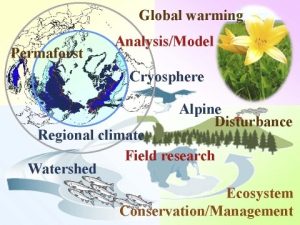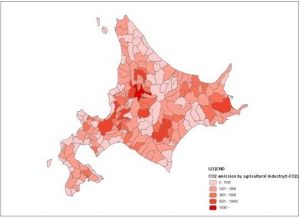The purpose of this course is to study human and ecological systems with a variety of structures and mechanisms, from three points of view: symbiosis in nature, environmental geography, and interdisciplinary approach, with the aim to produce experts with rich knowledge and problem-solving skills.
Applicants for master course can determine their supervisors during the entrance time and July.
Contents

Ecosystems and associated hydrological cycles have been established and maintained under various forcing disturbances of natural and anthropogenic causes, including climate change due to global warming. Environmental deterioration is apparent in high latitudinal and altitudinal regions, and vulnerable systems such as permafrost zones, plant communities, and rivers that reflect watershed conditions. Landscapes have been transformed by human activities, e.g., in Hokkaido that develops the specific climate, geography, and the subsequent ecosystems including wetlands and volcanoes. Disentangling these phenomena that interact with each other over multiple spatio-temporal scales requires an interdisciplinary approach having holistic understanding of underlying processes. On the basis of solid knowledge base in natural sciences, we address known and unknown interactive processes among atmosphere, biosphere, hydrosphere, cryosphere, geosphere and humanosphere. Research committed to provide solutions for better management of deteriorating ecological and hydrological processes is encouraged. Students gain skills to measure and analyze field survey data, and to establish models which describe the complicated processes.
Keywords: regional climate/meteorology, permafrost, ecosystem management/ conservation, field research, data analysis and modeling

The faculty members taking the environmental geographical approach will help students find effective solutions to environmental issues, conserve and protect geoecological diversity, understand geoecological systems in areas that has been developed on geomorphological and geological bases, develop measures to establish a society rich in sustainable ecological system services, and confront environmental challenges associated with resource use. As a result, an interdisciplinary perspective of the relationship between the environment and society is fostered, with an emphasis on mapping spatial and environmental systems. Field areas focused on are: alpine areas in the Himalaya and Karakorum; northern regions and Antarctica; transboundary areas such as the Pamirs and the Sea of Okhotsk and the Russian Far East; and Hokkaido, from the headwaters to the ocean, in the context of human-ecological systems. Prospective students will benefit by familiarizing with the following keywords: developing countries, Hokkaido, sustainable development, local communities, transboundary environmental conservation, land-ocean ecological interaction, GLOF (glacial lake outburst flood), natural history of terrestrial environmental structure, land use/land cover change, ecotourism, geotourism, national park management, PAs (protected areas), geoecology, GIS, and remote sensing.
Keywords: Sustainable development, trans-boundary environmental conservation, natural history of terrestrial environmental structure

This course aims to balance environmental conservation and economic growth and achieve a sustainable low-carbon society. Various approaches such as the Life Cycle Assessment (LCA) and the Input-Output Analysis, sustainability indices such as the Ecological Footprint, mapping using the Geographic Information System (GIS) will be applied for the purposes. In this course, students will acquire procedures to promote consensus building and decision making that suggest and implement socio-economic scenarios to reduce the greenhouse gas (GHG) emissions, such as government and municipality subsidies, carbon credits and carbon taxes. Previous studies include: (1) to suggest and demonstrate socio-economic scenarios for reducing the GHG emissions at the Hokkaido University Campus, (2) to estimate amounts of generation and demand of local biomass resources in Hokkaido using the GIS, and (3) to suggest to promote multiple use of renewable energies in line with local characteristics.
Keywords: sustainability, low-carbon society, social and economic system
TSUYUZAKI Shiro, ISHIKAWA Mamoru, SATO Tomonori, HAYAKAWA Yuichi, Masayuki SENZAKI, NEGISHI Junjiro, SHIRAIWA Takayuki